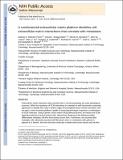| dc.contributor.author | Reticker-Flynn, Nathan E. | |
| dc.contributor.author | Malta, David F. Braga | |
| dc.contributor.author | Underhill, Gregory H. | |
| dc.contributor.author | Xu, Mary Jue | |
| dc.contributor.author | Winslow, Monte Meier | |
| dc.contributor.author | Hynes, Richard O | |
| dc.contributor.author | Jacks, Tyler E | |
| dc.contributor.author | Bhatia, Sangeeta N | |
| dc.contributor.author | Lamar, John | |
| dc.date.accessioned | 2014-04-11T14:52:16Z | |
| dc.date.available | 2014-04-11T14:52:16Z | |
| dc.date.issued | 2012-10 | |
| dc.date.submitted | 2012-07 | |
| dc.identifier.issn | 2041-1723 | |
| dc.identifier.uri | http://hdl.handle.net/1721.1/86102 | |
| dc.description.abstract | Extracellular matrix interactions have essential roles in normal physiology and many pathological processes. Although the importance of extracellular matrix interactions in metastasis is well documented, systematic approaches to identify their roles in distinct stages of tumorigenesis have not been described. Here we report a novel-screening platform capable of measuring phenotypic responses to combinations of extracellular matrix molecules. Using a genetic mouse model of lung adenocarcinoma, we measure the extracellular matrix-dependent adhesion of tumour-derived cells. Hierarchical clustering of the adhesion profiles differentiates metastatic cell lines from primary tumour lines. Furthermore, we uncovered that metastatic cells selectively associate with fibronectin when in combination with galectin-3, galectin-8 or laminin. We show that these molecules correlate with human disease and that their interactions are mediated in part by α3β1 integrin. Thus, our platform allowed us to interrogate interactions between metastatic cells and their microenvironments, and identified extracellular matrix and integrin interactions that could serve as therapeutic targets. | en_US |
| dc.description.sponsorship | National Institutes of Health (U.S.) (Grant K99-CA151968) | en_US |
| dc.description.sponsorship | National Institutes of Health (U.S.). Ruth L. Kirschstein National Research Service Award | en_US |
| dc.description.sponsorship | Stand Up To Cancer (SU2C/AACR) | en_US |
| dc.description.sponsorship | David H. Koch Institute for Integrative Cancer Research at MIT (CTC Project) | en_US |
| dc.description.sponsorship | Harvard Stem Cell Institute (SG-0046-08-00) | en_US |
| dc.description.sponsorship | National Cancer Center (Postdoctoral Fellowship) | en_US |
| dc.description.sponsorship | National Cancer Institute (U.S.) (U54CA126515) | en_US |
| dc.description.sponsorship | National Cancer Institute (U.S.) (U54CA112967) | en_US |
| dc.description.sponsorship | Howard Hughes Medical Institute | en_US |
| dc.description.sponsorship | Massachusetts Institute of Technology. Ludwig Center for Molecular Oncology | en_US |
| dc.language.iso | en_US | |
| dc.publisher | Nature Publishing Group | en_US |
| dc.relation.isversionof | http://dx.doi.org/10.1038/ncomms2128 | en_US |
| dc.rights | Article is made available in accordance with the publisher's policy and may be subject to US copyright law. Please refer to the publisher's site for terms of use. | en_US |
| dc.source | PMC | en_US |
| dc.title | A combinatorial extracellular matrix platform identifies cell-extracellular matrix interactions that correlate with metastasis | en_US |
| dc.type | Article | en_US |
| dc.identifier.citation | Reticker-Flynn, Nathan E., David F. Braga Malta, Monte M. Winslow, John M. Lamar, Mary J. Xu, Gregory H. Underhill, Richard O. Hynes, Tyler E. Jacks, and Sangeeta N. Bhatia. “A Combinatorial Extracellular Matrix Platform Identifies Cell-Extracellular Matrix Interactions That Correlate with Metastasis.” Nature Communications 3 (October 9, 2012): 1122. | en_US |
| dc.contributor.department | Whitaker College of Health Sciences and Technology | en_US |
| dc.contributor.department | Harvard University--MIT Division of Health Sciences and Technology | en_US |
| dc.contributor.department | Massachusetts Institute of Technology. Department of Biology | en_US |
| dc.contributor.department | Massachusetts Institute of Technology. Department of Electrical Engineering and Computer Science | en_US |
| dc.contributor.department | Ludwig Center for Molecular Oncology (Massachusetts Institute of Technology) | en_US |
| dc.contributor.department | Koch Institute for Integrative Cancer Research at MIT | en_US |
| dc.contributor.mitauthor | Reticker-Flynn, Nathan E. | en_US |
| dc.contributor.mitauthor | Malta, David F. Braga | en_US |
| dc.contributor.mitauthor | Winslow, Monte M. | en_US |
| dc.contributor.mitauthor | Lamar, John Michael | en_US |
| dc.contributor.mitauthor | Xu, Mary Jue | en_US |
| dc.contributor.mitauthor | Underhill, Gregory H. | en_US |
| dc.contributor.mitauthor | Hynes, Richard O. | en_US |
| dc.contributor.mitauthor | Jacks, Tyler E. | en_US |
| dc.contributor.mitauthor | Bhatia, Sangeeta N. | en_US |
| dc.relation.journal | Nature Communications | en_US |
| dc.eprint.version | Author's final manuscript | en_US |
| dc.type.uri | http://purl.org/eprint/type/JournalArticle | en_US |
| eprint.status | http://purl.org/eprint/status/PeerReviewed | en_US |
| dspace.orderedauthors | Reticker-Flynn, Nathan E.; Malta, David F. Braga; Winslow, Monte M.; Lamar, John M.; Xu, Mary J.; Underhill, Gregory H.; Hynes, Richard O.; Jacks, Tyler E.; Bhatia, Sangeeta N. | en_US |
| dc.identifier.orcid | https://orcid.org/0000-0001-5785-8911 | |
| dc.identifier.orcid | https://orcid.org/0000-0002-1293-2097 | |
| dc.identifier.orcid | https://orcid.org/0000-0002-4037-0108 | |
| dc.identifier.orcid | https://orcid.org/0000-0001-7603-8396 | |
| mit.license | PUBLISHER_POLICY | en_US |
| mit.metadata.status | Complete | |
